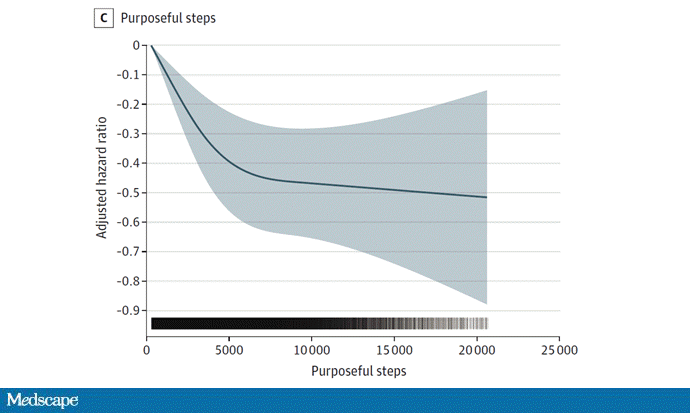Welcome to Impact Factor, your weekly dose of commentary on a new medical study. I'm Dr F. Perry Wilson of the Yale School of Medicine.
Ten thousand steps a day. I know you've heard the number. A number that reminds us to get up, move around, walk to the store instead of drive there.
Ten thousand steps is achievable, but not precisely easy, at least if you have a job that keeps you sitting in front of a computer for 8 hours a day. And, with smartphones in our pockets, knowing if you've hit that magic mark is trivial.

As far as health interventions go, encouraging people to walk 10,000 steps a day is pretty low-risk, and the price is certainly right. But the benefit is harder to tease out. That is why I got intrigued by a new study in JAMA Internal Medicine that looked at the link between steps taken and the risk for death and found something novel. It's not just how many steps you take. It's how you take them.
The study leveraged the UK Biobank cohort — a longitudinal study of British adults that collects a lot of data over time, but does not collect step counts.
So the authors emailed over 200,000 cohort participants, asking them if they'd wear a step counter — actually, a pretty fancy step counter called an Axivity AX3 accelerometer — 24 hours a day for 7 straight days.

Nearly 50% responded that they would — a really impressive response rate, I can say as someone who would give my own pinky for a 50% consent rate for one of my studies. Of course, not everyone wore the thing when they got it or had adequate data, but in the end the authors had a pretty huge dataset — 78,500 people with 7 days of step data.
And it wasn't just step counts. The authors wondered if all steps are the same. After all, there are the steps we take just sort of living our lives — walking to the water cooler, that sort of thing. The study called these "incidental steps." Then there were the purposeful steps — the steps we take when we are actually going somewhere. They also measured something they call the "peak-30 cadence" — think of it as the peak walking speed during the day. Are all steps created equal?
They linked these various metrics to all-cause mortality, as well as cardiovascular and cancer-specific mortality.
Let's start off simply with step count.

As you can see here, as step counts increased, the risk for death went down, but there are a couple of interesting things to note. First, there was no lower limit to benefit; 3000 steps was better than 2000, which was better than 1000. Second, the benefit seemed to level off after 10,000 steps or so. Maybe it is a magic number. Of course, the data get sparser out in the high step counts, so we don't want to jump to conclusions. Overall, the authors report a relative reduction in death rate of 36% for people hitting that 10,000 step mark.
All studies like this are plagued by what we often call "reverse causation." Maybe steps don't promote health; maybe healthier people take more steps. The authors account for this by excluding deaths that happened within 2 years of the step assessment — so we can be somewhat reassured that these weren't people who were very ill when the step counts were done. They also adjusted for a slew of factors, including age, sex, race, education, smoking, alcohol use, social deprivation, fruit and vegetable consumption, and so on. Perfect? No. But not bad.
But what's really interesting is the findings for those other types of steps. Putting the data altogether, there is a good signal that any steps are good, but purposeful steps — really walking somewhere — are a bit better. About 5000 purposeful steps had the same effect as 10,000 total steps.

And of course, how you walk matters. A higher step cadence was associated with reduced overall mortality too — with the best rate being about 75 steps a minute, which is definitely a brisk walk. But it might be worth it. The top 20% in the cadence analysis — the speed walkers, if you will — had a 34% lower death rate than the lowest 20%.

The results were broadly consistent when the cause of death was examined, though a bit stronger for prevention of cardiovascular deaths and a bit weaker for prevention of cancer deaths.
In the end, these data support what really is becoming a huge body of literature suggesting that sedentary lifestyles increase mortality risk. It also tells us that although 10,000 steps is really good, any steps are good, so if you usually get 2000, shoot for 4000. If get 4000, shoot for 8000.
And walk somewhere. Not every step is the same, and a purposeful walk — perhaps a brisk walk — will get you there a bit healthier.
F. Perry Wilson, MD, MSCE, is an associate professor of medicine and director of Yale's Clinical and Translational Research Accelerator. His science communication work can be found in the Huffington Post, on NPR, and here on Medscape. He tweets @fperrywilson and hosts a repository of his communication work at www.methodsman.com.
Follow Medscape on Facebook, Twitter, Instagram, and YouTube
Credits:
Image 1: F. Perry Wilson, MD, MSCE
Image 2: Axivity.com
Image 3: JAMA Internal Medicine
Image 4: JAMA Internal Medicine
Image 5: JAMA Internal Medicine
Medscape © 2022 WebMD, LLC
Any views expressed above are the author's own and do not necessarily reflect the views of WebMD or Medscape.
Cite this: F. Perry Wilson. It’s How You Walk -- Not Just Your Step Count -- That Matters - Medscape - Sep 13, 2022.












Comments